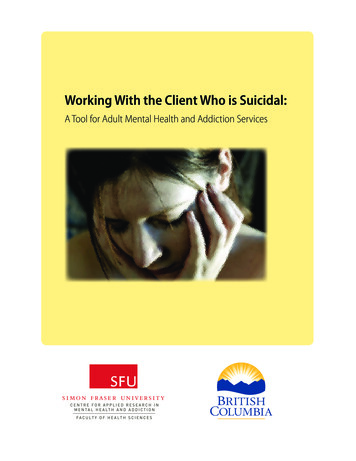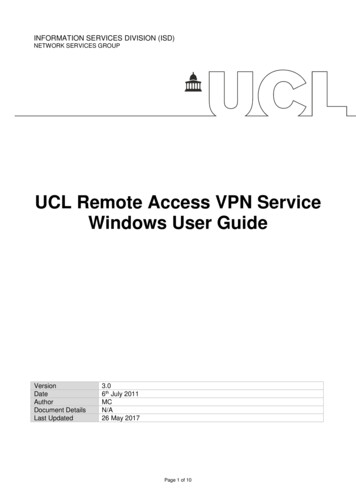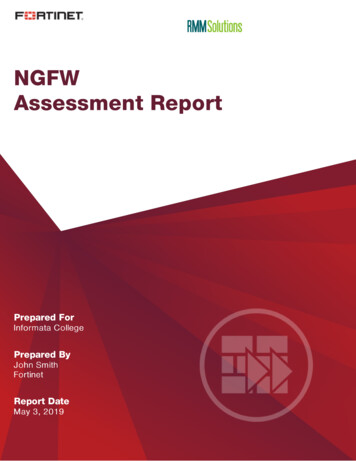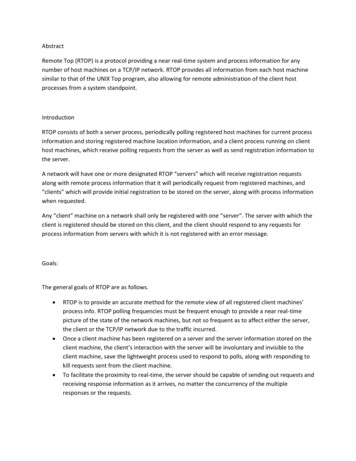
Transcription
Working With the Client Who is Suicidal:A Tool for Adult Mental Health and Addiction Services
Working With the Client Who is Suicidal: A Tool for Adult Mental Health and Addiction Services provides an overview ofrecommended practices in assessing and treating suicidal behaviour in adults. This document is consistent with the goalsidentified in the Blueprint for a Canadian National Suicide Prevention Strategy, developed by the Canadian Association forSuicide Prevention (CASP) in 2004. Specifically, this document responds to the following goals as identified by CASP: toincrease training for key gatekeepers, volunteers, and professionals regarding recognition of risk factors, warning signs andat-risk behaviours; to provide effective interventions; and to develop and promote effective clinical and professional practiceto support clients, families and communities.Accompanying documents include: Working with the Suicidal Patient: A Guide for Health Care Professionals Coping with Suicidal Thoughts Hope & Healing: A Practical Guide for Survivors of SuicideProject Management & CoordinationJoti Samra, PhD, RPsychResearch & WritingLynda Monk, MSW, RSWJoti Samra, PhD, RPsychEditingJoti Samra, PhD, RPsych; Jennifer White, EdD; Elliot Goldner, MDMinistry of Health Project LeadGerrit van der Leer, Director, Mental Health and AddictionThe British Columbia Ministry of Health sponsored development of the guide through the Centre for Applied Research inMental Health and Addiction (CARMHA), at the Faculty of Health Sciences at Simon Fraser University.This document is an adaptation of Practice Principles: A Guide For Mental Health Clinicians Working with Suicidal Childrenand Youth (2001), prepared by Joanna Ashworth for the Suicide Prevention Information and Resource Centre (SPIRC) atthe University of British Columbia, and funded by the British Columbia Ministry of Children and Family Development.Copies of this document can be downloaded at no cost from:Centre for Applied Research in Mental Health and Addiction: www.carmha.caB.C. Ministry of Health, Mental Health and Addiction: www.health.gov.bc.ca/mhdLibrary and Archives Canada Cataloguing in Publication DataMain entry under title:Working with the client who is suicidal : a tool for adult mental health and addiction services.Produced by the Centre for Applied Research in Mental Health and Addiction (CARMHA),for the Ministry of Health. Cf. Acknowledgements.Available also on the Internet.ISBN 978-0-7726-5746-61. Suicidal behavior - Treatment. 2. Suicide – Risk factors. 3. Suicide – Prevention.4. Suicidal behavior – British Columbia. 5.Mental health services - British Columbia.I. British Columbia. Mental Health and Addictions Branch. II. Simon Fraser University.Centre for Applied Research in Mental Health and Addiction.RC569 W67 2007616.85’8445C2007-960091-3
Qualifying StatementsThis guide is not a prescribed standard of care, and therefore cannot and does not stipulate a single correctapproach for all clinical situations. This document should be used as an information and planning tool only.Decisions regarding specific procedures for specific suicidal individuals remain the responsibility of theattending professional(s). Sophisticated clinical judgment is always a requisite, and it is important to alwayserr on the side of safety.The text has been prepared to advance and strengthen the ongoing work of mental health and addictionpractitioners. The target audience is assumed to be conversant with, and knowledgeable about, basic termsand practices in mental health and addiction settings, including: diagnostic categories, assessment procedures,therapeutic alliance, and clinical record-keeping.Throughout this document, information on various treatment modalities and orientations is provided. It isimportant to acknowledge that reading this guide does not imply that a clinician is conversant in a particulartreatment modality. Clinicians who are interested in further training and treatment are encouraged to pursuefurther continuing education activities.The bulk of the existing empirical literature on suicide focuses on risk assessment, and there is a notabledearth of evidence-based research focused on treatment of suicidality. However, reliable risk assessment andprediction of suicide remains an elusive task: the decision-making process is difficult to describe, and is notcaptured by simple compilation of risk factors. To be maximally useful, assessment must always occur withinthe context of a therapeutic alliance. The role of the clinician is to move beyond simple assessment of riskfactors, toward clinical management of risk, and therapeutic treatment of underlying contributors tosuicidality.
Getting the Most out of the DocumentThe document is organized into 6 main sections:1. Introduction, pp.1-42. General considerations for treating adult suicidality, pp.5-263. Identifying and assessing suicide risk, pp.27-364. Safety, treatment planning, and ongoing monitoring of suicidality, pp.37-575. Linkages between adult mental health and addiction services and the community, pp.58-646. Well-being issues for the clinician, pp.65-70While it is recommended that readers thoroughly acquaint themselves with the material provided in eachsection, in recognition of clinicians’ needs for up-to-date, clinically relevant, and timely information, thisdocument has been designed to enable quick access to specific content areas. The next section provides a quickvisual summary of each of the main content areas, and readers are encouraged to use this as a reference pointto gain access to topics of specific interest quickly and efficiently.
SummaryGeneral Considerations forWorking with Suicidal ClientsIdentifying & Assessing RiskSafety & Treatment Planningand Ongoing Monitoring ofSuicidalityEnhancing Linkages BetweenAdult Mental Health & AddictionServices and the CommunityUse clear definitions forclassifying, documenting anddiscussing suicidal behaviours(Section 2.2)Be familiar with risk andprotective factors for suicide(Section 3.1)Develop a safety plan for all clients Seek to establish proactive(Section 4.1)relationships and workcollaboratively with key serviceproviders, families andcommunity resources, to provideintegrated service delivery(Section 5.1)Develop a therapeutic alliance,making the clinical relationshipcentral to the treatment plan(Section 2.4)Use commonly understoodterms and definitions for levelsof suicide risk, e.g., non-existent,mild, moderate, high, andimminent (Section 3.2)Establish criteria for determiningwhen to recommendhospitalization or other secureprotected environment (Section4.2)Establish formal linkages betweenhospital emergency and mentalhealth centre for seamless referral(Section 5.2)Respond proactively to clientsdropping out from treatment(Section 2.5)Consider risk factors andpresenting difficulties based onboth subjective (self-reporting)and objective intent (Section 3.3)Involve the client, family, andother resources in thedevelopment of treatment andsafety plans (Section 4.3)Develop guidelines forsupporting the reintegration of aclient into the workplace after asuicide attempt (Section 5.3)To the extent possible, engagefamily members (spouse, parents)as key collaborators in treatmentplanning (Section 2.6)Assess level of suicidal intent;current ideation; plans; lethalityand availability of means;preparatory behaviour;cognitive rigidity and problemsolving abilities; impulse control;social isolation; recent losses(Section 3.3)Seek consultation and considerreferral needs for complexpsychiatric issues and addiction(Section 4.4)Support local media to reportresponsibly on the issue of suicidethrough active education efforts(Section 5.4)Seek regular clinical consultationwith peers and supervisors(Section 2.7)Understand the personalmeaning of suicide for the individual (Section 3.3)Use brief problem-solvingapproaches for treating suicidalideation (particularly in thepresence of Axis I disorders suchas depression) (Section 4.5)Develop guidelines forresponding to potentialcontagion effects in thecommunity. Provide postventionservices (Section 5.5)Create client-friendly mentalhealth and addiction services(Section 2.8)Recommend level of care tomatch level of risk identified(Section 3.4)Conceptualize a long-termtreatment approach for chronicsuicide attempts (particularly inthe presence of Axis II disorder)(Section 4.6)Support suicide preventioninitiatives in the community(Section 5.6)Seek informed consent andexplain limits of confidentiality(Section 2.9)When the risk to protectivefactors ratio is unclear, astructured and protectedenvironment is recommendeduntil a safety plan is developed(Section 3.4)Document and evaluate thetreatment process and outcomes(Section 4.7)Quality Improvement, SystemAnalysis, and Policy Development(Section 5.7)Consider the individualcharacteristics of the client,including cultural context anddevelopmental lifespan issues(Section 2.10)Suicidal behaviours aresymptoms, not a specific illness,and interventions must betailored to address underlyingconditions (Section 3.4)Regularly monitor suicidality(Section 4.8)
Table of Contents1. Introduction1.1 Purpose of the DocumentEnhancing Clinical Competency1.2 Intended Audience1.3 Models of Conceptualizing Suicidal Behaviour2. Adult Suicidality: General Considerations2.1 Suicides in B.C. – A Brief Overview2.2 Commonly Understood Terms for Suicidal Behaviour2.3 Myths about Suicide2.4 Therapeutic Alliance2.5 Adherence to Treatment2.6 Family Involvement2.7 Clinical Consultation2.8 Client-Friendly Healthcare Services2.9 Informed Consent, Confidentiality and Release of Information2.10 Special Populations2.10.1 Immigrant Populations2.10.2 Aboriginal Populations2.10.3 Lesbian, Gay, Bisexual or Transgender Clients2.10.4 Young Adults & Students2.10.5 Elderly Clients2.10.6 Developmental Disabilities2.10.7. Concurrent Disorders3. Identifying and Assessing Suicide Risk3.1 Identifying RiskDefinitionsUnderstanding Risk and Protective FactorsRisk Factors3.2 The Continuum of Risk for Suicide3.3 Assessing RiskAssessing Ideation, Intent and LethalityThe Personal Meaning of Suicidal Behaviour3.4 Clinical Decision-Making Summary4. Managing Safety and Treatment Planning4.1 Safety PlanningSafety PlansNo-Harm ContractsIntervention Approaches: Nondirective, Cooperative, and Directive4.2 Clients at High or Imminent RiskRecommendations for Hospitalization or other Secure Protected Environments4.3 Treatment PlanningChain Analysis: A Treatment Planning Strategy4.4 Mental Disorders Associated With SuicideAxis 13134353738394040414143434546
Mood DisordersMajor Depressive DisorderBipolar DisorderSubstance Use DisordersPsychosisAxis IIPersonality DisorderBorderline Personality DisorderAntisocial Personality Disorder4.5 Brief Problem Solving ApproachesCognitive Behavioural TherapyProblem Solving Skills TrainingSolution Focused Brief Therapy4.6 Dialectical Behavioural Therapy4.7 Documentation and Evaluation of Treatment PlanDocumentationEvaluation of Outcomes4.8 Monitoring SuicidalityOutpatient Management Considerations4.9 Legal Considerations5. Enhancing Linkages between Adult Mental Health and Addiction Services andthe Community5.1 Integrated Case Management5.2 Protocols between Acute Care and Community Mental Health and Addiction Services5.3 Suicide and the Workplace5.4 Media Education Guidelines5.5 Postvention in Mental Health and Addiction Practice5.6 Suicide Prevention in the Community5.7 Quality Improvement, System Analysis, and Policy Development6. Care for the Clinician6.1 Transference/Countertransference6.2 Clinical Consultation and Supervision6.3 Occupational HazardsBurnoutSecondary Traumatic StressCompassion Fatigue6.4 When a Client Dies by s84A-1 Suicides in British Columbia 1994-2003: Frequencies and Rates (per 100,000)A-2 Designated Mental Health Facilities in British ColumbiaA-3 Clinical ExamplesResourcesAssessment ToolsSuggested Reading for CliniciansResources for Clients & FamiliesProvincial Reviewers, National Revieweres and Advisory Committee8485879292100101109
Section OneIntroduction Suicide is a complex phenomenon emerging out of a dynamic interaction of biological, psychological,social, cultural, and spiritual factors. Suicidality is a symptom of underlying distress, and is the result of a combination of factors that causepsychological pain in the psyche, including underlying mental illness. Within a problem-solving conceptualization of suicidality, intervention efforts focus upon decreasingexperienced suffering, while simultaneously building upon a client’s capacity to cope with difficultiesfrom an emotional, cognitive, and behavioural perspective. A comprehensive approach to managing suicidality includes the following 3 stages:1. stabilization and safety of the client;2. assessment of temporal and distal risk factors; and3. ongoing management and active problem-solving of contributing factors. Working With the Client Who is Suicidal: A Tool for Adult Mental Health and Addiction Services
1.1. Purpose of the DocumentSuicide is a complex phenomenon that emerges out of adynamic interaction involving biological, psychological,social, cultural, and spiritual factors. Suicide is most oftenthe result of profound pain, hopelessness and despair: it isthe triumph of pain, fear and loss over hope.Mental health and addiction clinicians (hereafter referredto as “clinicians”) who work with young adult, adult andelderly populations are well aware of the potential risk forsuicide and suicidal behaviour among their clients. Yet,clinical work with suicidal clients is often identified as oneof the most challenging and anxiety-provoking areas ofpractice for many clinicians, irrespective of their level ofexperience.A comprehensive approach to suicide prevention andintervention - characterized by multiple strategiesimplemented across an array of key contexts, over time - islikely to yield the greatest benefit in reducing the incidenceof suicide and suicidal behaviour. The delivery of highquality assessment and treatment services, focused on bothreducing the risk factors for suicidal behaviour, whilesimultaneously bolstering protective factors, is a centralcomponent in overall suicide prevention efforts.Working With the Client Who is Suicidal: A Tool for AdultMental Health and Addiction Services provides an overviewof empirically supported assessment and interventionmethods for working with suicidal adults in mental healthand addiction settings. It is intended to serve as aninformation and planning tool. It aims to support andcomplement ongoing clinical training and in this spirit,contributes to the continuing professional development ofclinicians. The intent is to support clinicians byhighlighting the key practice principles, therapeutic tasks,and treatment strategies considered by the researchliterature, and by experienced clinicians, to be mosteffective in the assessment, management, and treatment ofsuicidal adults.Information provided in the document is based on: a review of the published empirical literature,including systematic reviews and high quality researchstudies; examination of existing clinical practicerecommendations; consultation with experts regarding current clinicalpractices, including clinicians and researchers; and, consultation with families who have had a familymember die by suicide.Enhancing Clinical CompetencyClinical competency in managing suicidal clients requiresa sound clinical knowledge and skills base, the emotionaltolerance and desire to assist others in distress, and a caringand respectful attitude toward clients and their families(Berman & Cohen-Sandler, 1983). Knowledge of riskfactors and the capacity to respond in an effective wayto clients who present a risk of suicide are distinct, yetintertwined areas of clinical competency (Bongar, 1992).Additionally, it is important to be aware of specific riskpopulations, to understand the relationship between thelaw and mental health practices, and to appreciate theprocess of informed consent, and associated limitationsregarding confidentiality.Clinical competency is supported and enhanced byclinician well-being (Stamm, 1995). This document alsoaddresses specific well-being needs relevant to the clinicianworking with a suicidal population, including grief issuesrelated to working with suicidal clients, burnoutprevention strategies, and clinical supervision needs.Working With the Client Who is Suicidal: A Tool for Adult Mental Health and Addiction Services
1.2 Intended AudienceClinicians have a significant role in the assessment, clinicalmanagement, and treatment of adults who are at risk forsuicide. The document works on the assumption thatreaders are proficient mental health and addictionpractitioners who are dedicated to increasing their skill andknowledge in the assessment and treatment of suicidality inadults.It has been designed to support local planning and practiceefforts and will be of particular relevance to the followinggroups: adult mental health and addiction clinicians;psychiatric consultants;psychogeriatric assessment teams;mental health emergency services staff;outpatient psychiatry programs;clinical mental health and addiction programmanagers and supervisors;mental health and addiction directors of healthauthorities;public health units;home and community care services;family physicians; andplanners of health authorities.manage and treat suicidal behaviour by attending to twovariables: the client’s experienced (and expressed) distressand their tolerance for this distress. To understand thecomplexity of suicidal behaviour, Schneidman (1993)offers a simple framework organized around three mainquestions, which form the crux of suicide assessment andtreatment efforts: What is it about the client’s current situation orcontext that explains, facilitates, and maintains his orher psychological distress? What is the client’s demonstrated (or stated) distresstolerance? What can be done clinically to reduce the client’spsychological distress in the short term and developimproved tolerance for this distress in the long term?Chiles and Strosahl (1995, as cited in Bilsker & Forster,2003, p. 135) further postulate that:When any one of us experiences the following cognitiveconditions (“The Three I’s”), we will seriously considersuicide as a coping behavior. These conditions are:(1) physical or emotional pain that is experienced asIntolerable, unbearably distressing; (2) a life situationperceived as Interminable, that is seen as continuingunchanged; (3) a life situation that is perceived asInescapable, such that no coping action already tried orconceived will make a significant difference.1.3 Models of Conceptualizing SuicidalBehaviourProblem-Solving Model of Suicidal BehaviorThe move to integrate the multiple theories of suicide –epidemiological, philosophical, sociocultural, sociological,psychiatric, psychological, psychodynamic, andbiological – is reflected in the framework offered bySchneidman (1993). Schneidman’s view is that suicide iscaused by psychological pain in the psyche, and hesuggests that the clinician can best understand, assess,Reduction of suffering ntionCoping enhancementCoping enhancementProblemSolvingSuicideWorking With the Client Who is Suicidal: A Tool for Adult Mental Health and Addiction Services
Within the model, a client’s problem-solving capacities areemphasized. Intervention efforts focus upon decreasingexperienced suffering, while simultaneously building upona client’s capacity to cope with difficulties from anemotional, cognitive, and behavioural perspective.It is important to underscore the significant effects thatmental health conditions – such as depression and anxietydisorders – have on an individual’s capacity to problemsolve. Acknowledging the impact of mental healthconditions on an individual’s capacity to problem-solve cancounter client’s tendencies to self-blame (Bilsker & Forster,2003). Furthermore, it is important to assess for and treatunderlying mental health conditions given their potentialcontribution to increasing suicidality. However, it isimportant to acknowledge that treatment for suicidality isnot necessarily synonymous with treatment for depression.Treatment of underlying depression is often necessary butnot sufficient for reduction of suicidality.A comprehensive approach to managing suicidalityincludes the following 3 stages:1. When a client is in the midst of a suicidal crisis,intervention must first focus on immediatestabilization and safety of the client. In cases of highor imminent risk, stabilization may take the form ofinpatient hospitalization. This stage would also involvethe development of a safety plan (see 4.1; also seeaccompanying document, Coping with SuicidalThoughts which can be helpful for both clients andtheir families/significant others).2.addressing the acute crisis, but rather targetingunderlying risk factors which may elevate the risk offuture crises.3.Appropriate management of suicidality requires morethan simple delineation of factors that contributed toincreased risk – it requires ongoing management andactive problem-solving of contributing factors,including treatment of any underlying mental illness(e.g., combination of pharmacotherapy andcounselling for treatment of mental illness) andproblem-solving focused on increasing coping ability.Although there is limited evidence that conclusivelyestablishes the efficacy of any specific intervention inreducing the likelihood of repeat suicide attempts (vander Sande, Buskens, et al., 1997; Hawton, Arensman,Townsend, et al., 1998), clients who are suffering from anacute emotional crisis that is associated with suicidalideation or actual attempt may benefit from beingpresented with a problem-solving model of suicide(Bilsker & Forster, 2003). This strategy would involveproviding a client with an explanation of the suicidal crisisthat is framed in a manner that conveys appreciation ofthe client’s difficulties, and promotes problem-solving,which may ultimately be used to resolve the suicidal crisis.Presentation of this type of model can help to enhance aclient’s sense of meaning, control, and hope, and providea framework for which further intervention efforts can beplaced (Bilsker & Forster, 2003).Once a client’s safety has been ensured, it is importantto understand the factors that contributed to theclient’s suicidal crisis, via a thorough risk assessmentof factors temporally connected to the crisis(e.g., situational factors such as argument with spouseor loss of job), as well as distal risk factors(e.g., recurrent panic attacks; family history of suicide).Appropriate risk management requires more than justWorking With the Client Who is Suicidal: A Tool for Adult Mental Health and Addiction Services
Section TwoAdult Suicidality: General Considerations Use clear definitions to identify, classify, document, and discuss suicidal behaviours. Understand and challenge personal beliefs, attitudes, stigma, and myths about suicide. Recognize that the relationship between clinician and client is probably the most important factor in themanagement and treatment of suicidality. Actively involving families, friends, and significant others in the management and treatment of a suicidalclient. Obtain informed consent from clients. Recognize that exceptions to confidentiality include circumstanceswhere a client is judged to be at imminent risk of harm. Recognize the unique characteristics of special populations that may elevate risk for suicidality, and/orimpact prevention and treatment considerations. Working With the Client Who is Suicidal: A Tool for Adult Mental Health and Addiction Services
2.1 Suicides in B.C. – A Brief OverviewKey facts about suicide: The losses faced by families, friends, workplaces andcommunities as a result of death by suicide areenormous. Worldwide, more people die by suicidethan by homicide and war. In B.C., suicide is the second leading cause of deathamong young people aged 15-24. There were a total of 492 suicide deaths in theprovince of British Columbia in 2004 and 370(75 per cent) of these were males (B.C. Vital Statistics20051,2). For every death by suicide there are likely between50 to 100 attempts (Bland, Newman & Dyck, 1994;Health Canada, 1994). Provincially, approximately 80 per cent of all gundeaths are suicides. Psychiatric disorders have been consistently identifiedas risk factors for suicide and suicidal behaviour.and treatment. This includes situations where aconsultation is required, when the client transfers toanother service provider, or when hospitalization isindicated or necessary.DefinitionsSuicideDeath from injury, poisoning, or suffocation where there isevidence (either implicit or explicit) that the injury wasself-inflicted and the person intended to kill him/herself.Note: Expressions like “successful suicide” and “committedsuicide” are strongly discouraged. Even the phrase “completedsuicide,” which is commonly used to refer to a death bysuicide, is increasingly falling out of favour among those inthe suicide prevention field, as it continues to connote anaccomplishment of sorts. “Died by suicide” is the phrasethat survivors of suicide (those who have lost a loved one tosuicide) and practitioners in the field prefer, as it is the mostneutral, clear, and straightforward way to describe this typeof death.Suicide Attempt with Injuries2.2 Commonly Understood Terms forSuicidal BehaviourAn action resulting in non-fatal injury, poisoning, orsuffocation where there is evidence (either implicit orexplicit) that the injury was self-inflicted and that theperson intended to kill him/herself.Use clear definitions for identifying, classifying,documenting and discussing suicidal behaviours.Suicide Attempt without InjuriesThere is a lack of clarity in accepted and routinely applieddefinitions of suicide and suicidal behaviour, which hassignificant implications for clinical practice. Using a set ofcommonly understood, logically defined terms for suicidalbehaviour will help to improve clarity, consistency andprecision between clinicians and across service settingsregarding the assessment of risk, ongoing management,A potentially self-injurious behaviour where there isevidence (either implicit or explicit) that the personintended to kill him/herself.1 Note, however, that due to delays in determining the exact cause ofdeath, this number is likely to increase. Over the period 1994 to 2003,the median number of additional deaths determined to be suicideafter the annual report was published was 81 (derived from B.C. VitalStatistics 2005), implying that the actual number of suicides in B.C.in 2004 might be over 500 once all the undecided causes of death aredetermined2 For a 10-year summary of suicide deaths by five-year age groups inB.C. for 1994-2003, see Appendix 1.Working With the Client Who is Suicidal: A Tool for Adult Mental Health and Addiction Services
Instrumental Suicide-Related Behaviour/ParasuicidePotentially self-injurious behaviour where there is evidence(either implicit or explicit) that the person did not intendto kill him/herself (e.g., no intent to die) and the personwished to use the appearance of intending to kill him/herself in order to attain some other end (e.g., to seek help,to punish others, or to communicate pain). Instrumentalsuicide-related behaviour, also called parasuicidal behaviour,can occur with injuries, without injuries, or with fataloutcome (e.g., accidental death).Note: Interpreting parasuicidal behaviour as “justmanipulation” is both counter-therapeutic and potentiallyvery dangerous, since a person can suffer a fatal outcomewith these behaviours regardless of intent. Intent can bedifficult to determine since ambivalence is often a keycomponent to suicidal behaviours.Conditions associated with the emergence of self-mutilationinclude: physical and sexual abuse from a significant other,exposure to marital violence, grief and loss issues, illness orsurgery, and/or familial impulsive self-destructive behaviour(e.g. alcoholism, drug abuse, suicide or acts of selfmutilation). Unlike suicide, self-mutilating acts such asself-cutting are understood as being a means for reducingtension and discomfort. The act of self-mutilation rapidlyreduces feelings of alienation, tension, anger and anxiety(Walsh & Rosen, 1988).2.3 Myths about SuicideThere are many misconceptions concerning suicide, bothamong the general public and among professionals.Clinicians need to explore their personal beliefs andattitudes, and challenge any stigma and myths that theymay hold.Suicidal ThreatAny interpersonal action (verbal or non-verbal) stoppingshort of directly self-harming that can reasonably beinterpreted as communicating that a suicidal act or othersuicide-related behaviour might occur in the near future.Suicide IdeationAny self-reported thoughts of engaging in suicide-relatedbehaviour.³Suicidal CrisisAn acute increase in suicidality, which may involve thinkingabout, planning, intending, or attempting suicide.Self-Mutilation/Self-Harming BehavioursSelf-harming behaviours include “all behaviours involvingdeliberate infliction of direct physical harm to one’s ownbody without any intent to die as a consequence of thebehaviour.”³3 Definitions adapted from O’Carrol et al., 1996 and Simon & Favazza,2001. Working With the Client Who is Suicidal: A Tool for Adult Mental Health and Addiction Services
Twelve Must-Know Myths aboutSuicidal Clients (Adapted from Rosenthal, 2003)Myth 1: Suicidal people don’t give warning signs.Fact: Nearly everybody who attempts or dies by suicidecommunicates his or her intent. The person may talk aboutsuicide, repeatedly joke about it, write abo
Mental Health and Addiction (CARMHA), at the Faculty of Health Sciences at Simon Fraser University. This document is an adaptation of Practice Principles: A Guide For Mental Health Clinicians Working with Suicidal Children and Youth (2001), prepared by Joanna Ashworth for the Suicide Prevention Information and Resource Centre (SPIRC) at











